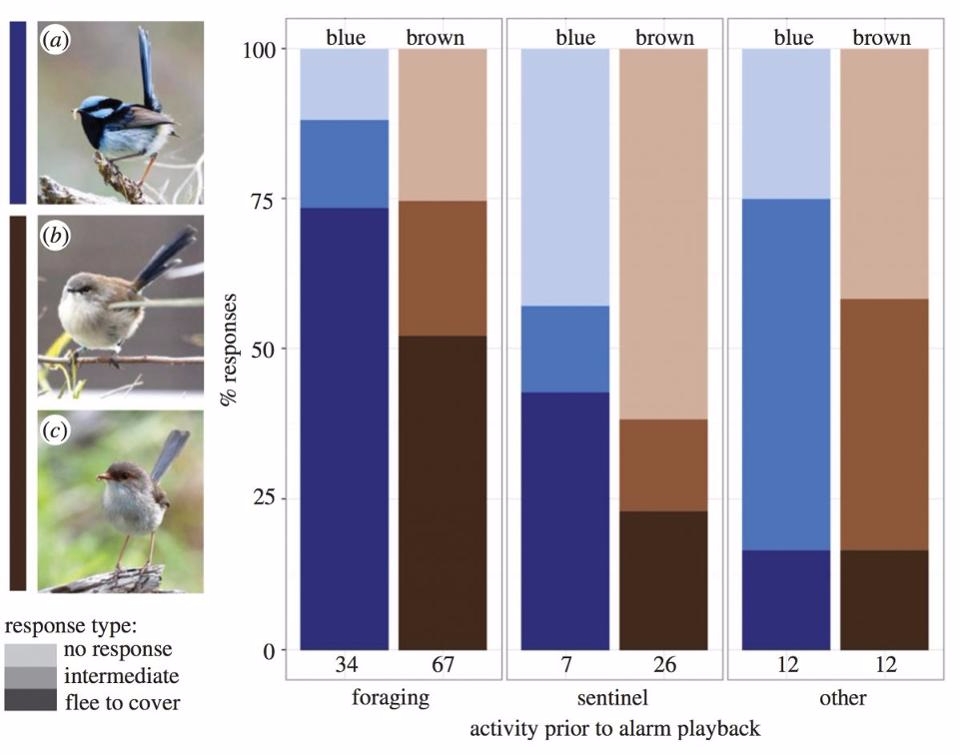
Brightly colored hairs are likely to attract mating opponents, but there is a high risk for predators. Males, especially birds, change their clothes with spectacular and noticeable feathers depending on the season. How do these brightly colored birds protect themselves from predators?
Prominent breeding plumage attracts attention of predators.
Intuitive and conspicuous color attracts females' attention but also attracts predator attention. There are, however, few studies on whether these birds know that their brilliant colors are noticeable to others, and whether their behavior is different depending on how well they are found by predators.
There are no published studies to date on how the prominent colors affect the behavior of birds in signaling.
Will birds with visible colors behave strangely to avoid danger? A group of scientists in Australia studied a small bird called Fairy Wren.
Fairy wrens are small birds with two colors depending on sex, which are common in southeastern Australia and Tasmania.
Young females and young males have grayish upper body, pale gray abdomen, and white neck. The adult male has a long, blue tail, and the adult female has bright orange feathers around the eyes.
When the breeding season begins, mature males show off their gorgeous blue feathers. There are bright blue hair, ear parts, wings, tail, black hairy face, neck, back and dark blue neck. The more feathers are plush, the more they can appeal genetically to females.
Fairy wrens are territorial birds, and a pair dominates other birds. This group contains several male helper males.

The dominant couple is socially monogamous, but not faithful. They mate with other birds. Seventy percent of their offspring lay with other pairs.
Females are not tricky when choosing males, but they choose males that are the first to have feathers and keep the feathers for the longest as second and third husbands. This blue feather lasts 11-12 months of the year. So the male fairy wren should stay in blue for as long as possible.
Males molt twice a year. It changes from dark brown to blue and black. It is easy to compare the behaviors of dark brown males and blue males in the same period of the year, because the male fairy wrens are not dressed with breeding feathers at the same time. Scientists have conducted field studies because of the large number of bird populations at Listerfield Park in Victoria, Australia.
They were brown or blue. It also served as a useful control of individual differences due to personality and various social factors.
The bright blue fairy wrens flew on the bus.
They sound different alarms about different kinds of dangers. That is, when you look at a public predator, you make a high-frequency four-factor "high-risk" call and a low-frequency single-factor "low-risk" call.
Fairy wrens reacted differently to low-risk alarm calls, but immediately ran away when high-risk alarms rang.
Scientists have recorded the gender, feather color (brown or blue) and preliminary activity of the bird. The activities included food gathering, sentinel activities, feathering, rest, and tweezers. The color of the fairy wrens other than the study group and the distance from the study group were also recorded.
When sending an alert, blue-feathered males responded more strongly to brown males and were more likely to flee regardless of previous activities.
Blue males were more likely to flee on low-risk alert calls, hiding longer and more time spent browsing. The blue birds hid in search of food, but less time spent collecting food than brown birds.
Interesting was the response of the birds outside the study group to risk alarms. These spectator birds ran away when they were around a blue male when high alarms rang and spent less time in hiding and searching around.
Studies have shown that noticeable color increases the risk of predation independently of other factors, and that visible birds are at greater risk of being attacked by carnivores.
A brilliantly colored male fairy wren is a coward compared to boasting a bold search for females and people nearby.
![[Parenting] Birds with distinct colors are prudent birds. parenting birds with distinct colors are prudent birds](https://moontore.com/wp-content/uploads/2019/02/parenting-birds-with-distinct-colors-are-prudent-birds-1200x700.jpg)


